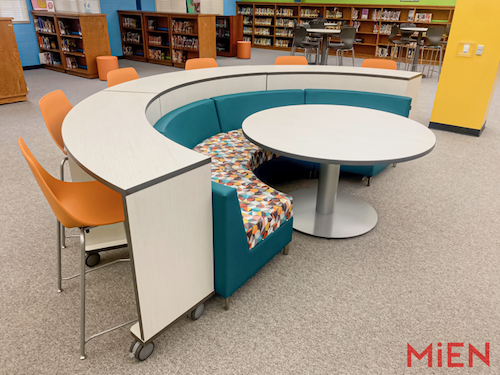Key points:
- Prioritize high-need schools and ensure technology is in place from the beginning
- With updated media centers, schools can support modern learning goals and student activities
- See related article: 4 ways we designed collaborative learning spaces
It’s been about two years since we received the Elementary and Secondary School Emergency Relief (ESSER) funding that we needed to be able to update our aging media centers. Not only were the furniture and fixtures old, but most of the seating was made of cloth and nearly impossible to sanitize or disinfect.
We used this ESSER funding opportunity—plus some additional funding from other sources—to thoroughly review our current facilities across 27 different schools. We sought out the facilities with the highest need, knowing that some of them had been upgraded in recent years. Others, however, were still using furniture from 1972—the same year that the schools had opened.
Here are the five steps we took with our partner MiEN to update our aging media centers into flexible, inviting spaces that are conducive to modern learning styles:
1. Prioritize schools with the most need. We looked at the schools that had the highest need and prioritized two middle schools whose facilities were in the worst shape. They had shelving that was 6’ X 8’ feet long and totally connected, plus seating that was old and uncomfortable. We sat down and decided that those would be the first schools to get the upgraded media centers, and we’d tackle the high schools next (the elementary schools would be last because we needed to secure some supplemental funding before we could actually finish those).
2. Set parameters for design. The design of our new media centers had to be different, progressive, and sustainable. This furniture would have to last another 30 years because that’s probably how long it’ll take before we can order it again. There also had to be a way to reposition the furniture to support collaboration among teachers and students, and to create places for both small and large group instruction. Finally, we wanted mobile shelving and an easy way to disinfect and clean all of the furniture and surfaces.
3. Incorporate technology early in the game. We wanted the media center to have mobile power. We ordered some power strips that could be mobilized or moved around because some of our media centers only had three total outlets; you have to think about that when you’re using technology. Also, make sure the tables are big enough to hold your laptops and other items. Make sure your wi-fi infrastructure is in place. Digital content is important—particularly in middle and high school—and you have to make sure that you provide the space and capability for massive downloads at one time for the entire class.
4. Don’t get too many cooks in the kitchen. We got our principals involved at the outset and let them look at the final designs (and offer any input), but we didn’t let everyone weigh in—knowing that it can easily delay or hold up progress. To keep it as simple as possible, we involved the principals and the media coordinators, who then independently shared information with individual teachers as they saw fit.
5. Choose pieces that encourage collaboration. Make sure the tables can be redesigned and reconfigured. Sometimes our middle and elementary schools work on robotics or LEGOs and need the tables to be able to be put together or pulled apart. Finally, make sure the furniture and the other items that you’re ordering complement the collaboration and instruction that needs to take place in that space.
We kicked off our new media installations in February, which means some students saw the new facilities for the first time when they returned for the 2023-24 school year. Once all of our existing middle and high school media centers are upgraded, we plan to use the modern spaces in new ways.
For example, we’d like to roll out esports in the high school media centers at some point, because we now have the facilities to be able to do that. We’ve been in the 21st century now for 23 years; it’s time to start thinking about the next one.
Related:
How to create engaging active learning environments
5 of the biggest education trends in 2023
- 4 ways to encourage play in education - April 25, 2024
- CoSN IT Leader Spotlight: Lisa Higgins - April 25, 2024
- It’s time to pay student teachers - April 25, 2024

